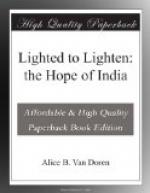In the house at the far end of the street, Arul is first on her feet, first to rub the sleep from her eyes. There is no ceremony of dressing, no privacy in which to conduct it if there were. Arul rises in the same scant garment in which she slept, snatches up the pot of unglazed clay that stands beside the door, poises it lightly on her hip, and runs singing to the village well, where each house has its representative waiting for the morning supply. There is the plash of dripping water, the creak of wheel and straining rope, and the chatter of girl voices.
[Illustration: A temple in south India]
The well is also the place for making one’s morning toilet. Arul dashes the cold water over her face, hands, and feet. No soap is required, no towel—the sun is shining and will soon dry everything in sight. Next comes the tooth-brushing act, when a smooth stick takes the place of a brush, and “Kolynos” or “Colgate” is replaced by a dab of powdered charcoal. Arul combs her hair only for life’s great events, such as a wedding or a festival, and changes her clothes so seldom that it is better form not to mention it.
Breakfast is equally simple,—and the “simple life” at close range is apt to lose many of its charms. In the corner of the one windowless room that serves for all domestic purposes stands the earthen pot of black gruel. It is made from the ragi, little, hard, round seeds that resemble more than anything else the rape seed fed to a canary. It looks a sufficiently unappetizing breakfast, but contentment abounds because the pot is full, and that happens only when rains are abundant and seasons prosperous. The Russian peasant and his black bread, the Indian peasant and his black gruel—dark symbols these of the world’s hunger line.
There is no sitting down to share even this simple meal, no conception of eating as a social event, a family sacrament. The father, as lord and master, must be served first; then the children seize the one or two cups by turn, and last of all comes Mother. Arul gulps her breakfast standing and then dashes into the street. She is one of the village herd girls; the sun is up and shining hot, and the cattle and goats are jostling one another in their impatience to be off for the day.
The dry season is on and all the upland pastures are scorched and brown. A mile away is the empty bed of the great tank. A South Indian tank in our parlance would be an artificial lake. A strong earth wall, planted with palmyras, encircles its lower slope. The upper lies open to receive surface water, as well as the channel for the river that runs full during the monsoon months. During the “rains” the country is full of water, blue and sparkling. Now the water is gone, the crops are ripening, and in the clay tank bottom the cattle spend their days searching for the last blades of grass.




